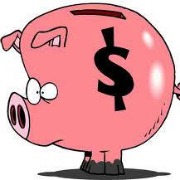Despite a huge downward revision of Q1 GDP growth from 2.4% to 1.8%, data for Q2 look decent. Durable goods orders look OK, home sales are good and despite sequestration and the payroll tax increase, consumer spending is holding up surprisingly well and savings rates actually edged up to 3.2% in May from 2.8% in April. Given the continued economic headwinds, however, Q2 GDP will be no better than 1.5%.
Tag Archives: Consumer Spending
A Miserable Median
A healthy economy exhibits many things including steady growth in median (and mean) income. Unfortunately, after peaking in ‘99 at $53,252, inflation adjusted median income in the US is now $49,445 – almost $4,000 lower than in ’99 and back to where it was in ’96! The same is true for mean income. Since consumer spending is 70% of GDP, the lack of income growth necessarily results in anemic GDP growth.
Raiding the Piggy Bank
Despite good job growth, consumer spending is growing faster than personal income, driving the savings rate down to 3.7%, the lowest rate in years. Why? Unemployment insurance income is falling. In Jan and Feb 551K jobs were created while 550K lost unemployment benefits. What’s going on is the wages these folks are earning aren’t much more than the UI they lost. I also bet personal income data will be revised up.
Shop or Drop?
Consumers are spending but for how much longer? Over the past year disposable income is down, savings has fallen from 5.3% to 3.5%, household net worth has fallen by $2.4 trillion as house prices keep falling and credit card debt is up. Luxury spending is strong but chain-store sales were down in Oct and Nov as were purchases by the middle class. I don’t think households can keep spending at the elevated levels of late.
Inflation? What inflation
 Researchers at the Federal Reserve Bank of San Francisco find that 2.7% of consumer spending went to Chinese made items. Moreover, for every $1 spent on Chinese made goods, fully 55 cents goes to US businesses for services like shipping, marketing, sales and advertising. So, even if inflation in China heats up, US consumers are not likely to feel it outside of clothing and shoes where China has 36% of all sales.
Researchers at the Federal Reserve Bank of San Francisco find that 2.7% of consumer spending went to Chinese made items. Moreover, for every $1 spent on Chinese made goods, fully 55 cents goes to US businesses for services like shipping, marketing, sales and advertising. So, even if inflation in China heats up, US consumers are not likely to feel it outside of clothing and shoes where China has 36% of all sales.
Food is Expensive
In poor countries people spend much more on food than we do. In the Philippines 47% of income is spent on food. The amount is 45% in India, 40% in Vietnam, 36% in Indonesia, 33% in Thailand, 30% in China, 22% in Singapore, 14% in S. Korea. Here it’s just 8%. Because it’s so high in poor countries, recent increases in food prices are reducing consumer spending and threatening GDP growth.
Inflation Trumps Prospects
The good: Consumer spending rose in Feb for an 8th consecutive month, spending rose 0.7% in February after a 0.3% increase in January. The Bad: Adjusted for inflation, consumer spending was up just 0.3% last month after being flat in Jan. The Ugly: inflation accelerated at its fastest rate since June ‘09 and the data provide more evidence that higher prices for food and energy are depressing economic growth.
Bifurcation
The key reason investors believe the economy is improving is because the surveys; the ISMs, consumer confidence and regional Fed polls of manufacturing sentiment have been strong. Auto and chain store sales were also decent. But other data reports like industrial production, single-family starts, real consumer spending, core capex orders and shipments and construction spending were all down. Think bifurcation.


